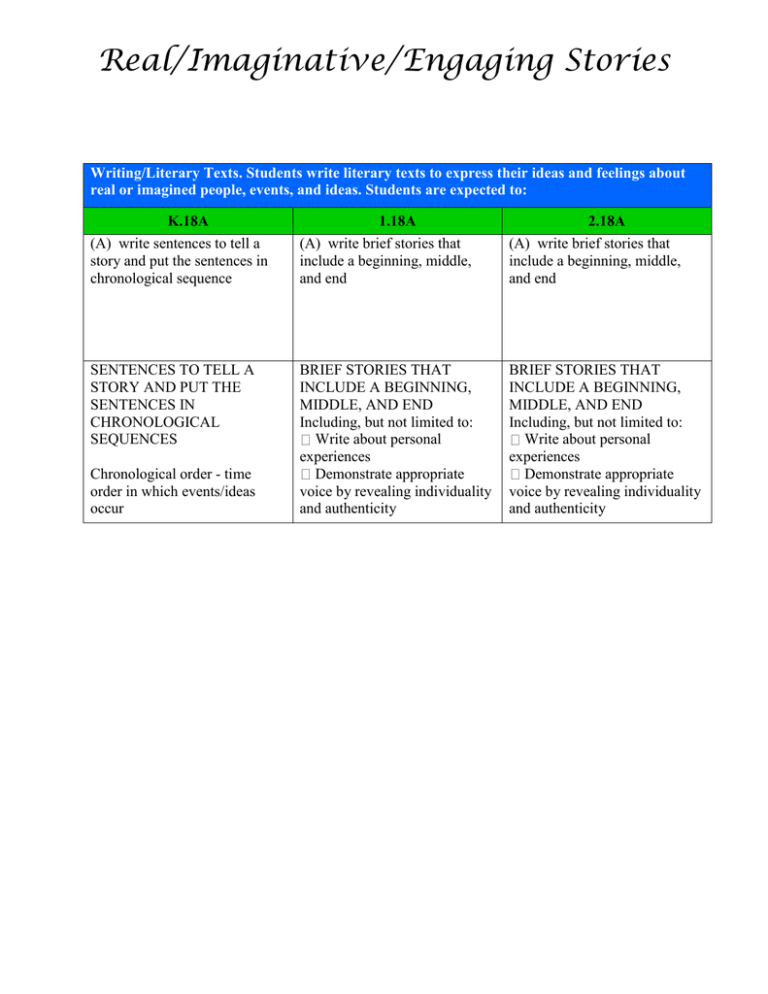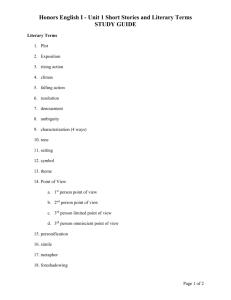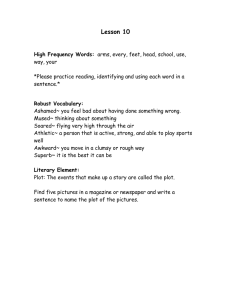Real/Imaginative/Engaging Stories
advertisement

Real/Imaginative/Engaging Stories Writing/Literary Texts. Students write literary texts to express their ideas and feelings about real or imagined people, events, and ideas. Students are expected to: K.18A (A) write sentences to tell a story and put the sentences in chronological sequence 1.18A (A) write brief stories that include a beginning, middle, and end 2.18A (A) write brief stories that include a beginning, middle, and end SENTENCES TO TELL A STORY AND PUT THE SENTENCES IN CHRONOLOGICAL SEQUENCES BRIEF STORIES THAT INCLUDE A BEGINNING, MIDDLE, AND END Including, but not limited to: Write about personal experiences Demonstrate appropriate voice by revealing individuality and authenticity BRIEF STORIES THAT INCLUDE A BEGINNING, MIDDLE, AND END Including, but not limited to: Write about personal experiences Demonstrate appropriate voice by revealing individuality and authenticity Chronological order - time order in which events/ideas occur Writing/Literary Texts. Students write literary texts to express their ideas and feelings about real or imagined people, events, and ideas. Students are expected to: 3.18A 4.16A 5.16A (A) write imaginative stories that build the plot to a climax and contain details about the characters and setting (A)Write imaginative stories that build the plot to a climax and contain details about the characters and settings. (A) write imaginative stories that include: (i) a clearly defined focus, plot, and point of view; (ii) a specific, believable setting created through the use of sensory details; and (iii) dialogue that develops the story IMAGINATIVE STORIES THAT BUILD THE PLOT TO A CLIMAX AND CONTAIN DETAILS ABOUT THE CHARACTERS AND SETTINGS Including, but not limited to: Components of plot Characters (physical traits, feelings, and personality, actions, and reasons for actions) IMAGINATIVE STORIES THAT BUILD THE PLOT TO A CLIMAX AND CONTAIN DETAILS ABOUT THE CHARACTERS AND SETTINGS Including, but not limited to: Components of plot Characters (physical traits, feelings, and personality, actions, and reasons for actions) IMAGINATIVE STORIES THAT INCLUDE Purpose for setting: Create problems for characters Develop a plot Better understand the characters and their conflicts Plot - the basic sequence of events in a story (includes problem and solution) Purpose for setting: Create problems for characters Develop a plot Better understand the characters and their conflicts Plot - the basic sequence of events in a story (includes problem and solution) (i) a clearly defined focus, plot, and point of view Point of view - the perspective from which the events in the story are told the vantage point or stance Plot - the basic sequence of events in a story (includes problem and solution) (ii) a specific, believable setting created through the use of sensory details Setting - time and place in which a narrative occurs (past, future, present, real, or imaginary place) Purpose for setting: Create problems for characters Develop a plot Understand the characters and their conflicts (iii) dialogue that develops the story Including, but not limited to: Tells about the characters Tells about the relationships among the characters Dialogue - the lines spoken between characters in fiction or a play Writing/Literary Texts. Students write literary texts to express their ideas and feelings about real or imagined people, events, and ideas. Students are expected to: 6.15A 7.15A 8.15A (A) write imaginative stories that include: (i) a clearly defined focus, plot, and point of view; (ii) a specific, believable setting created through the use of sensory details; (iii) dialogue that develops the story (A) write an imaginative story that: (i) sustains reader interest; (ii) includes well-paced action and an engaging story line; (iii) creates a specific, believable setting through the use of sensory details; (iv) develops interesting characters; (v) uses a range of literary strategies and devices to enhance the style and tone A) write an imaginative story that: (i) sustains reader interest; (ii) includes well-paced action and an engaging story line; (iii) creates a specific, believable setting through the use of sensory details; (iv) develops interesting characters; (v) uses a range of literary strategies and devices to enhance the style and tone IMAGINATIVE STORIES THAT INCLUDE (i) a clearly defined focus, plot, and point of view Plot - the basic sequence of events in a story. In conventional stories, plot has three parts: rising action, climax, and falling action. Components of Plot: Exposition - (can introduce problem) information needed to understand the story (background information), may include the narrator and point of view Narrative hook - inciting incident; introduction of the conflict or the story problem Rising action/problem/conflict – builds on the problem- events leading up to the climaxobstacles- highest point of interest Turning point/climax - decide to deal with the problem- turning point- when the character tries to resolve the complication/ problem (complication tension between the opposing forces)the action that occurs when the problem is about to be solved Falling action - events that solve problem- leading to the solution Denouement/Resolution-Closure - events that bring the story to a close Point of view - the perspective from which the events in the story are told (ii) a specific, believable setting created through the use of sensory details Purpose for setting Create problems for characters Develop a plot Better understand the characters and their conflicts Setting - the time and place in which a narrative occurs (iii) dialogue that develops the story Including, but not limited to: Tells about the characters Tells about the relationships between the characters Dialogue - a conversation between two or more characters- what the characters say AN IMAGINATIVE STORY THAT (i)sustains reader interest (ii) includes well-paced action and an engaging story line (iii) creates a specific, believable setting through the use of sensory details Purpose for setting Create problems for characters Develop a plot Better understand the characters and their conflicts Setting - the time and place in which a narrative occurs (iv) develops interesting characters Including, but not limited to: Physical traits Dialect Feelings Personality Actions Reasons for actions Changes in characters (v) uses a range of literary strategies and devices to enhance the style and tone Examples of literary strategies and devices: Sensory detail Use of literal and non-literal meaning Simile Metaphor Imagery Personification Hyperbole Irony Oxymoron Pun Tone - the author’s particular attitude, either stated or implied in the writing Style - the way something is written, in contrast to its content. (e.g., Hemingway’s writing style is terse, blunt, and conversational.) It is the manner of expression of the writer produced by choice of words, grammatical structures, literary devices, and all the possible parts of language use. Style is more about how it is written than what is written. AN IMAGINATIVE STORY THAT (i)sustains reader interest (ii) includes well-paced action and an engaging story line (iii) creates a specific, believable setting through the use of sensory details Purpose for setting Create problems for characters Develop a plot Better understand the characters and their conflicts Setting - the time and place in which a narrative occurs (iv) develops interesting characters Including, but not limited to: Physical traits Dialect Tells about the characters Feelings Personality Actions Reasons for actions Changes in characters (v) uses a range of literary strategies and devices to enhance the style and tone Examples of literary strategies and devices: Sensory detail Use of literal and non-literal meaning Simile Metaphor Imagery Personification Hyperbole Irony Oxymoron Pun Tone - the author’s particular attitude, either stated or implied in the writing Style - the way something is written, in contrast to its content. (e.g., Hemingway’s writing style is terse, blunt, and conversational.) It is the manner of expression of the writer produced by choice of words, grammatical structures, literary devices, and all the possible parts of language use. Style is more about how it is written than what is written. Engaging Stories Writing/Literary Texts. Students write literary texts to express their ideas and feelings about real or imagined people, events, and ideas. Students are responsible for at least two forms of literary writing. Students are expected to: E1.14A E2.14A E3.14A E4.14A (A) write an engaging story with a well-developed conflict and resolution, interesting and believable characters, and a range of literary strategies (e.g., dialogue, suspense) and devices to enhance the plot (A) write an engaging story with a well-developed conflict and resolution, interesting and believable characters, a range of literary strategies (e.g., dialogue, suspense) and devices to enhance the plot, and sensory details that define the mood or tone; AN ENGAGING STORY Including, but not limited to: Well-developed conflict and resolution Interesting and believable characters Range of literary strategies and devices to enhance the plot Sensory details that define mood and tone Use of appropriate voice Examples of literary strategies and devices (techniques): Dialogue Suspense Irony Satire Paradox Symbolism Allegory (A) write an engaging story with a well-developed conflict and resolution, complex and nonstereotypical characters, a range of literary strategies (e.g., dialogue, suspense) and devices to enhance the plot, and sensory details that define the mood or tone AN ENGAGING STORY Including, but not limited to: Well-developed conflict and resolution Complex and nonstereotypical characters Range of literary strategies and devices to enhance the plot Sensory details that define mood and tone Use of appropriate voice Examples of literary strategies and devices (techniques): Dialogue Suspense Irony Satire Paradox (A) write an engaging story with a well-developed conflict and resolution, a clear theme, complex &nonstereotypical characters, a range of literary strategies (e.g., dialogue, suspense), devices to enhance the plot, and sensory details that define the mood or tone AN ENGAGING STORY Including, but not limited to: Well-developed conflict and resolution A clear theme Complex and nonstereotypical characters Range of literary strategies and devices to enhance the plot Sensory details that define mood and tone Use of appropriate voice Examples of literary strategies and techniques: Dialogue Suspense Irony Satire Mood - the atmosphere or feeling created by the writer in a literary work or passage. Mood can be expressed through imagery, word choice, setting, voice, and theme. i.e,, the mood evoked in Edgar Allan Poe’s work is gloomy and dark. Tone - the author’s particular attitude toward his/her subject, either stated or implied in the writing Mood - the atmosphere or feeling created by the writer in a literary work or passage. Mood can be expressed through imagery, word choice, setting, voice, and theme. i.e., the mood evoked in Edgar Allan Poe’s work is gloomy and dark. Tone - the author’s particular attitude toward his/her subject, either stated or implied in the writing AN ENGAGING STORY Including, but not limited to: Well-developed conflict and resolution Interesting and believable characters Range of literary strategies and devices to enhance the plot Use of appropriate voice Examples of literary strategies and devices (techniques): Dialogue Suspense Irony Satire Paradox Mood - the atmosphere or feeling created by the writer in a literary work or passage. Mood can be expressed through imagery, word choice, setting, voice, and theme. For example, the mood evoked in Edgar Allan Poe’s work is gloomy and dark. Tone - the author’s particular attitude toward his/her subject, either stated or implied in the writing







